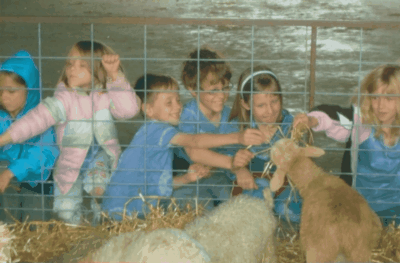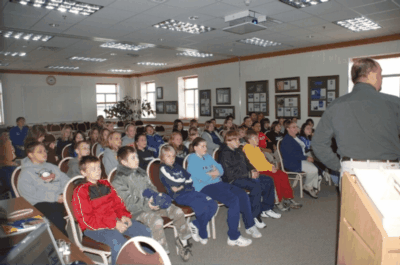|
School tours - May 2008

The Agricultural Research Service's Fort Keogh Livestock and Range Research Laboratory at Miles City hosted the first-graders from Highland Park Elementary School in Miles City. They get to pet and feed the animals and then they go inside for a talk about where food comes from and what a first grader needs to eat each day. They are given a printout from the USDA My Pyramid website to take home and discuss with their parents. They finish their tour with a snack of crackers and jerky and receive a pin with the ARS4kids website on it where they can go to get loads of information. (Pictures coutesy of Y. Carr)

The Agricultural Research Service's Fort Keogh Livestock and Range Research Laboratory at Miles City hosted the fifth-graders from Lincoln Elementary School in Miles City on May 8 as part of the lab’s annual school tour week. Their visit to the laboratory included presentations by ARS scientists and technicians on the research that Fort Keogh does and how it applies to agriculture.
The tours started with a presentation by ARS scientists Dr. Richard Waterman, Nutritionist, and Dr. Tom Geary, Research Physiologist, about Fort Keogh's research mission and how the four scientific disciplines at the station--genetics, range, physiology, and nutrition--work together to identify how rangeland and grazing animals can be used more efficiently to capture solar energy. The scientists and the students also discussed the USDA Food Pyramid and the components of a healthy diet for a typical fifth-grader.
Next, molecular genetics technician Kathy Meidinger visited with the students about the history and basics of genetics, using trivia, puppets, and a PCT paper taste test to help the students understand how DNA chromosomes control hereditary traits.
Also during the visit, the students toured the laboratories, stopping by the nutrition lab to see how a cow’s stomach works and seeing first-hand a sheep that is fitted with a device called a "fistula," which allows observation of the sheep's digestive process. The students also got a close look at a sample of partially digested material from the sheep's stomach, which allowed them to see all of the micro-organisms that contribute to digestion of forages that provide essential nutrients to the sheep.
Then the students were off to the range lab to learn about how plants grow, develop and interact with microbes. They learned that most of the dry mass of plants is made of carbon molecules, and that the carbon comes from carbon dioxide in the air. The students held samples of dry ice and learned that it is made from frozen carbon dioxide.
The next stop was the physiology lab, where the students learned about the processes involved in successful reproduction in cattle. Use of an ultrasound was demonstrated to visualize a heart beat in the youngsters, much as it is used to diagnose a successful pregnancy.
The last stop was the pizza table, where the students learned that everything in the pizza comes from agriculture.
The students were accompanied by their teachers, Amanda Wambolt and Vanessa Gruba, and several parents and grandparents.
ARS is the chief scientific research agency of the U.S. Department of Agriculture, and has operated the lab at Miles City since 1924. (Pictures taken by Mary Wambolt)
|